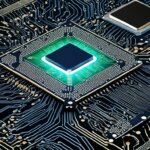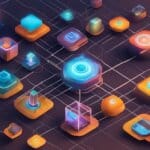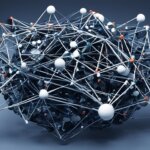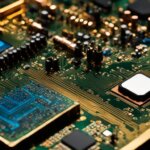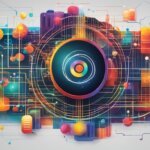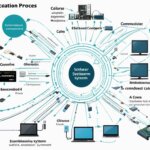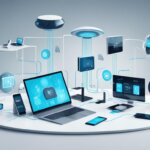Table of Contents
The Internet of Things (IoT) is a network of interrelated devices that connect and exchange data with other IoT devices and the cloud. IoT devices, such as smart devices, are embedded with technology like sensors and software. These devices can include mechanical and digital machines, as well as consumer objects. IoT enables data exchange over a network without human interaction, creating a seamless network of interconnected devices.
With IoT, devices can communicate, share information, and collaborate to perform various tasks, ultimately enhancing the overall efficiency and functionality of the connected network. This network enables the exchange of real-time data, allowing businesses and consumers to make informed decisions and automate processes.
How Does IoT Work?
An IoT ecosystem consists of web-enabled smart devices with embedded systems, such as processors, sensors, and communication hardware. These devices collect, send, and act on data acquired from their environments. IoT devices share sensor data by connecting to an IoT gateway, where the data can be analyzed or sent to an edge device for local analysis. IoT devices can communicate with other related devices and perform tasks without human intervention. The connectivity, networking, and communication protocols used in IoT depend on the specific applications deployed. IoT can also utilize artificial intelligence (AI) and machine learning to simplify data collection and analysis.
Why is IoT Important?
IoT plays a crucial role in improving various aspects of business operations, resulting in enhanced efficiency, customer experience, and cost savings. By leveraging IoT technologies, organizations can benefit in multiple ways, making it an essential component of modern business strategies.
Enhanced Efficiency
Implementing IoT solutions allows businesses to monitor and optimize their overall processes. With real-time data collection and analysis, organizations can identify bottlenecks, streamline workflows, and automate repetitive tasks. This not only improves operational efficiency but also frees up valuable resources, enabling employees to focus on more strategic initiatives.
Improved Customer Experience
IoT enables businesses to deliver personalized and seamless customer experiences. By collecting and analyzing customer data, companies can gain valuable insights into their preferences and behaviors. This information can be used to tailor products and services, offer targeted promotions, and provide proactive support, ultimately enhancing customer satisfaction and loyalty.
Cost Savings
One of the significant advantages of IoT is its potential for cost savings. By optimizing processes, reducing waste, and enhancing resource management, businesses can lower their operational costs. IoT-enabled predictive maintenance, for example, helps prevent equipment breakdowns and unplanned downtime, reducing maintenance expenses and improving overall productivity.
Increased Employee Productivity
IoT technology empowers employees to work more efficiently and productively. With connected devices and smart tools, employees can access real-time information, collaborate seamlessly, and automate manual tasks. This not only improves productivity but also fosters innovation and creativity within the workforce.
Informed Business Decisions
IoT generates a wealth of data that can be leveraged to make informed and data-driven business decisions. By analyzing vast amounts of real-time data, organizations can identify trends, uncover insights, and make accurate predictions. This enables businesses to adapt quickly to changing market conditions, anticipate customer needs, and make proactive strategic decisions.
Revenue Generation
IoT opens up new opportunities for revenue generation. By offering IoT-based products and services, businesses can tap into new markets and monetize data. Additionally, IoT enables businesses to create innovative business models, such as subscription-based services or outcome-based pricing, creating new revenue streams and driving growth.
Industry-specific Benefits
IoT brings industry-specific benefits across various sectors. In manufacturing, IoT enables real-time monitoring of production lines, improving operational efficiency and quality control. In healthcare, IoT facilitates remote patient monitoring, enhancing patient care and reducing hospital readmissions. In retail, IoT enables personalized marketing campaigns and optimized inventory management, enhancing the customer experience and increasing sales.
In summary, IoT is vital for businesses due to its ability to improve efficiency, customer experience, and cost savings. By leveraging IoT technologies and embracing digital transformation, businesses can unlock new opportunities, gain a competitive edge, and drive sustainable growth.
Pros and Cons of IoT
Just like any technology, the Internet of Things (IoT) has its advantages and disadvantages. Let’s take a closer look at both sides of the coin.
Advantages of IoT
- Access to information: IoT allows users to access information from anywhere and at any time. This enables real-time monitoring and control of connected devices and systems.
- Improved communication: IoT facilitates seamless communication between devices, enabling them to share data and work together to perform tasks efficiently.
- Efficient data transfer: IoT enables the transfer of large amounts of data quickly and seamlessly, improving the speed and accuracy of data analysis.
- Large-scale data collection: IoT devices collect vast amounts of data from various sources, providing valuable insights for businesses and industries.
- Automation: IoT automation streamlines processes, reduces human intervention, and enhances operational efficiency.
- Enhanced healthcare: IoT in healthcare enables remote patient monitoring, personalized care, and improved health outcomes.
Disadvantages of IoT
- Increased security risks: With a wide range of interconnected devices, IoT poses security vulnerabilities, exposing sensitive data and creating new attack vectors.
- Device management challenges: Managing numerous devices across different platforms and manufacturers can be complex and time-consuming.
- Compatibility issues: IoT devices from different manufacturers may have compatibility problems, making integration and interoperability challenging.
- Potential system bugs: System bugs or failures in one IoT device can potentially affect other connected devices, leading to data corruption or malfunction.
IoT offers numerous advantages, such as access to information, efficient communication, and automation. However, it also presents challenges, including security risks and device compatibility issues.
Despite these considerations, the benefits of IoT far outweigh the drawbacks. With proper implementation and security measures in place, businesses and individuals can harness the full potential of IoT to drive innovation, improve efficiency, and enhance the overall quality of life.
| Advantages | Disadvantages |
|---|---|
| Access to information from anywhere | Increased security risks |
| Improved communication between devices | Device management challenges |
| Efficient data transfer | Compatibility issues |
| Large-scale data collection | Potential system bugs |
| Automation | |
| Enhanced healthcare |
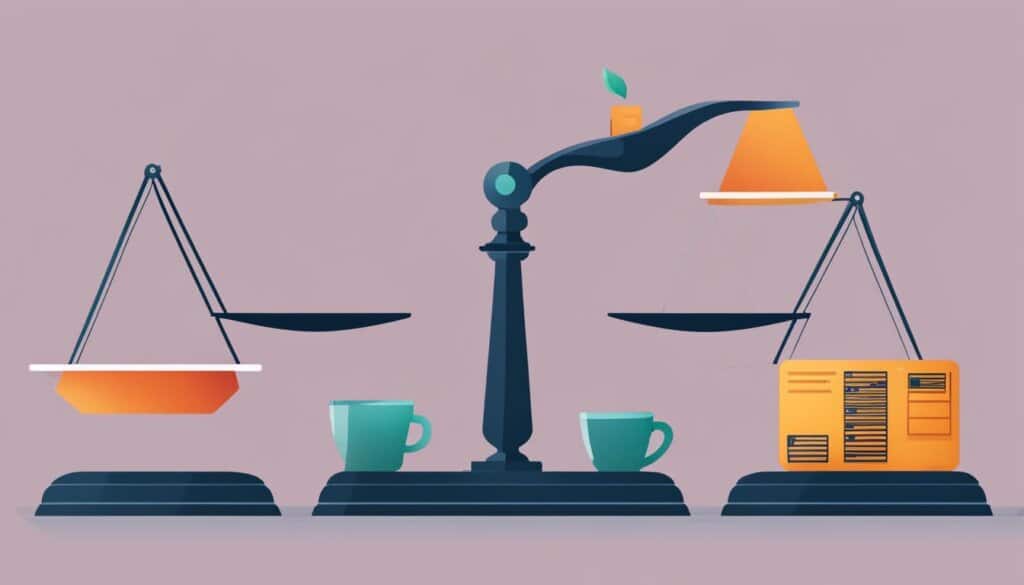
As shown in the table above, the advantages of IoT range from increased access to information to enhanced healthcare. On the other hand, there are several potential challenges, including security risks and compatibility issues. However, with careful planning and implementation, businesses and individuals can leverage the benefits of IoT while mitigating its drawbacks.
IoT Standards and Frameworks
IoT standards play a crucial role in ensuring interoperability and seamless communication between devices. These standards are developed by esteemed organizations such as the International Electrotechnical Commission (IEC) and the Institute of Electrical and Electronics Engineers (IEEE). To facilitate efficient device communication, various protocols are employed within these standards.
IPv6 over Low-Power Wireless Personal Area Networks (6LoWPAN) is a standard that enables the transmission of IPv6 packets over low-power wireless networks, allowing IoT devices to communicate with each other and with the internet.
Zigbee is a widely adopted standard for wireless communication in IoT applications. It operates on low-power and low-data-rate networks, making it suitable for smart home devices, industrial automation, and healthcare systems.
Data Distribution Service (DDS) is a communication standard designed for real-time data distribution and integration in IoT systems. It enables efficient and secure data exchange between devices and subsystems.
Connectivity technologies such as Constrained Application Protocol (CoAP), Advanced Message Queuing Protocol (AMQP), Long-Range Wide Area Network (LoRaWAN), and MQTT (Message Queuing Telemetry Transport) are utilized to enable efficient and reliable device communication within IoT networks.
IoT frameworks provide a structured approach for developing IoT applications. These frameworks offer a range of tools, services, and libraries that simplify IoT application development and deployment.
Some popular IoT frameworks include:
- Amazon Web Services (AWS) IoT
- Arm Mbed IoT
- Microsoft Azure IoT Suite
- Calvin
The synergy between IoT standards, protocols, and frameworks, combined with the power of cloud computing and big data analytics, enables organizations to harness the maximum potential of the IoT. Security and privacy technologies also play a critical role in ensuring the integrity and confidentiality of IoT data.
Examples of IoT Applications
The Internet of Things (IoT) has revolutionized various industries with its wide range of applications. Let’s explore some examples of how IoT is utilized in everyday life:
1. Smart Home Devices
IoT technology has brought us smart home devices that enhance convenience, security, and energy efficiency. Smart thermostats, like the popular Nest Learning Thermostat, allow homeowners to control their heating and cooling remotely, optimizing energy usage and reducing utility bills. Security systems integrated with IoT technology, such as Ring Doorbell, enable users to monitor their homes from anywhere using their smartphones, ensuring peace of mind.
2. Wearables
Wearable devices have become increasingly popular, offering users a range of features to monitor their health and fitness. Smartwatches are one example of wearable IoT devices that provide various functionalities, including tracking physical activity, heart rate monitoring, sleep analysis, and receiving notifications from smartphones. Popular brands like Apple, Samsung, and Fitbit offer a wide range of smartwatches with advanced features.
3. Personal Medical Devices
IoT has greatly impacted the healthcare industry by enabling the development of personal medical devices. Glucose monitors, such as Dexcom G6, use IoT technology to provide real-time blood sugar readings for individuals with diabetes, enhancing their ability to manage their condition effectively. Remote patient monitoring systems, like Philips’ CareSage, allow healthcare professionals to remotely track patient vital signs and optimize care delivery.
4. Autonomous Vehicles
Autonomous vehicles, also known as self-driving cars, are a prime example of IoT applications. These vehicles rely on a network of sensors, cameras, and IoT connectivity to navigate the road, detect obstacles, and make informed decisions. Companies like Tesla, Waymo, and Uber are at the forefront of developing and implementing autonomous vehicle technology, aiming to revolutionize transportation and improve road safety.
5. Healthcare
IoT has transformed healthcare by improving patient care and enabling remote monitoring. In hospitals, IoT devices can track patient data and send real-time updates to healthcare providers, enhancing diagnosis and treatment decisions. Telehealth platforms utilize IoT technology to enable virtual consultations and remote patient monitoring, allowing patients to receive healthcare services from the comfort of their homes.
| IoT Applications | Benefits |
|---|---|
| Smart Home Devices | Convenience, energy efficiency, improved security |
| Wearables | Health and fitness tracking, real-time notifications |
| Personal Medical Devices | Remote patient monitoring, enhanced healthcare management for chronic conditions |
| Autonomous Vehicles | Improved road safety, efficient transportation |
| Healthcare | Enhanced patient care, remote monitoring capabilities |
Benefits of IoT in Specific Industries
IoT technology has brought significant benefits to specific industries, transforming operations and improving various aspects of business. Let’s explore how IoT has revolutionized healthcare, manufacturing, retail, agriculture, and transportation.
IoT in Healthcare: Improved Patient Care
IoT has revolutionized healthcare by enabling remote patient monitoring and improved medical care. With IoT devices, healthcare providers can remotely monitor patient vitals and track medication adherence, ensuring timely interventions and personalized treatment. This technology has the potential to enhance patient outcomes, reduce hospital readmissions, and empower individuals to actively manage their health.
IoT in Manufacturing: Increased Efficiency and Productivity
In the manufacturing industry, IoT has become a game-changer, increasing efficiency and productivity. IoT sensors embedded in machines enable real-time monitoring of performance, predicting maintenance needs, and optimizing processes. This improves equipment uptime, minimizes downtime, enhances production efficiency, and reduces costs. With IoT, manufacturers can streamline operations, automate workflows, and achieve higher levels of productivity.
IoT in Retail: Enhanced Customer Experience
Retailers have embraced IoT to enhance the customer experience by leveraging personalized offers and efficient inventory management. IoT-enabled smart shelves can track stock levels, gather data on customer preferences, and send real-time notifications to store associates for restocking. This ensures product availability, improves customer satisfaction, and allows retailers to offer tailored promotions and recommendations.
IoT in Agriculture: Optimized Farming Techniques
IoT has revolutionized agriculture by optimizing farming techniques through soil and weather monitoring. Farmers can deploy IoT devices to collect data on soil moisture levels, temperature, humidity, and other environmental factors. This data enables informed decision-making, precise irrigation management, and crop protection. IoT empowers farmers to implement sustainable practices, reduce resource wastage, and increase yields.
IoT in Transportation: Improved Vehicle Performance and Logistics
In the transportation industry, IoT plays a pivotal role in improving vehicle performance and logistics. IoT devices can track and monitor vehicles in real-time, providing insights into fuel consumption, engine health, and driver behavior. This data enables proactive maintenance, optimized route planning, and efficient delivery management. By leveraging IoT technology, transportation companies can reduce operational costs, enhance customer satisfaction, and optimize their overall logistics operations.
In conclusion, IoT has significant benefits in various industries, including healthcare, manufacturing, retail, agriculture, and transportation. From improving patient care and increasing efficiency to enhancing the customer experience and optimizing farming techniques, IoT technology has revolutionized operations in these sectors. Embracing IoT can open doors to new opportunities and drive success in the ever-evolving digital landscape.
Risks and Challenges in IoT
While the Internet of Things (IoT) brings numerous benefits, it also introduces certain risks and challenges that must be addressed. One of the primary concerns is the security and privacy risks associated with IoT devices and networks. With the increasing interconnectedness of devices and the vast amount of data being exchanged, there is a heightened risk of cyberattacks, data breaches, and unauthorized access to personal information.
Interoperability is another challenge in the IoT ecosystem. Different devices often use different standards and protocols, making it difficult for them to communicate and work seamlessly together. This interoperability issue can hinder the overall efficiency and effectiveness of IoT systems, requiring additional efforts to establish compatibility and integration.
Data overload is another challenge that arises from the massive amount of data generated by IoT devices. This data needs to be analyzed and processed efficiently to extract valuable insights and drive informed decision-making. However, the sheer volume of data can overwhelm organizations, necessitating advanced data management and analysis techniques to handle the data effectively.
The cost and complexity of implementing and managing IoT systems is also a significant challenge. Building and deploying IoT infrastructure, integrating various devices and platforms, and maintaining the system can be expensive and complex. Organizations need to consider not only the initial investment but also the ongoing operational costs and technical expertise required.
In addition to the technical challenges, regulatory and legal hurdles also pose a risk in the IoT landscape. Organizations must ensure compliance with various regulations and laws related to data protection, privacy, and cybersecurity. Failure to meet these obligations can result in severe penalties and reputational damage, making it critical for businesses to navigate the regulatory landscape effectively.
FAQ
What is the Internet of Things (IoT)?
The Internet of Things (IoT) is a network of interrelated devices that connect and exchange data with other IoT devices and the cloud. IoT devices, such as smart devices, are embedded with technology like sensors and software. These devices can include mechanical and digital machines, as well as consumer objects.
How does IoT work?
IoT consists of web-enabled smart devices with embedded systems, such as processors, sensors, and communication hardware. These devices collect, send, and act on data acquired from their environments. They share sensor data by connecting to an IoT gateway, where the data can be analyzed or sent to an edge device for local analysis. IoT devices can communicate with other related devices and perform tasks without human intervention. IoT uses specific connectivity, networking, and communication protocols depending on the specific applications deployed. IoT can also utilize artificial intelligence (AI) and machine learning to simplify data collection and analysis.
Why is IoT important?
IoT is important as it helps improve efficiency, customer experience, and cost-saving for businesses. It allows organizations to monitor overall business processes, enhance employee productivity, integrate adaptable business models, make better business decisions, and generate more revenue. IoT also has industry-specific benefits in manufacturing, transportation, utility, agriculture, infrastructure, home automation, healthcare, finance, retail, and more.
What are the pros and cons of IoT?
IoT offers advantages such as access to information from anywhere at any time, improved communication between devices, efficient data transfer, large-scale data collection, automation, and enhanced healthcare. However, there are also disadvantages, including increased security risks, device management challenges, compatibility issues between devices from different manufacturers, and potential system bugs that could corrupt other connected devices.
What are the IoT standards and frameworks?
IoT standards are developed by organizations like the International Electrotechnical Commission and the Institute of Electrical and Electronics Engineers. Examples of IoT standards include IPv6 over Low-Power Wireless Personal Area Networks (6LoWPAN), Zigbee, and Data Distribution Service (DDS). These standards use specific protocols for device communication, such as Constrained Application Protocol (CoAP), Advanced Message Queuing Protocol (AMQP), Long-Range Wide Area Network (LoRaWAN), and MQTT. IoT frameworks include Amazon Web Services (AWS) IoT, Arm Mbed IoT, Microsoft Azure IoT Suite, and Calvin. IoT also relies on technologies like cloud computing, big data analytics, and security and privacy technologies.
What are some examples of IoT applications?
IoT has various applications, including smart home devices like thermostats and security systems, wearables like smartwatches, personal medical devices like glucose monitors and remote patient monitoring systems, autonomous vehicles, and more. These applications offer convenience, improved healthcare, efficiency, and safety.
What are the benefits of IoT in specific industries?
IoT has significant benefits in specific industries. In healthcare, IoT enables remote patient monitoring and improved medical care. In manufacturing, IoT increases efficiency and productivity by optimizing processes and monitoring machine performance. In retail, IoT enhances the customer experience through personalized offers and inventory management. In agriculture, IoT optimizes farming techniques through soil and weather monitoring. In transportation, IoT improves vehicle performance and logistics by monitoring and optimizing routes and tracking shipments.
What are the risks and challenges in IoT?
While IoT offers many benefits, it also poses risks and challenges. These include security and privacy risks, interoperability issues due to different device standards, data overload and the need for efficient data analysis, cost and complexity of implementing and managing an IoT system, and compliance with various regulations and laws related to data protection and cybersecurity.


